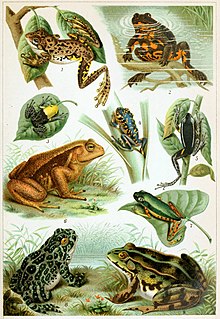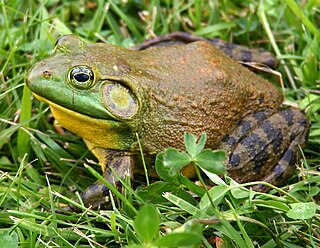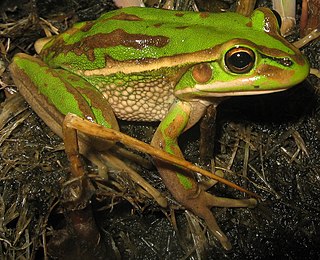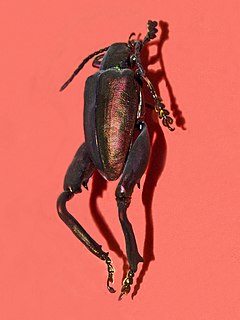
A frog is any member of a diverse and largely carnivorous group of short-bodied, tailless amphibians composing the order Anura. The oldest fossil "proto-frog" appeared in the early Triassic of Madagascar, but molecular clock dating suggests their origins may extend further back to the Permian, 265 million years ago. Frogs are widely distributed, ranging from the tropics to subarctic regions, but the greatest concentration of species diversity is in tropical rainforest. There are over 6,300 recorded species, accounting for around 88% of extant amphibian species. They are also one of the five most diverse vertebrate orders. Warty frog species tend to be called toads, but the distinction between frogs and toads is informal, not from taxonomy or evolutionary history. All toads are frogs, but not all frogs are toads.

The African clawed frog is a species of African aquatic frog of the family Pipidae. Its name is derived from the three short claws on each hind foot, which it uses to tear apart its food. The word Xenopus means "strange foot" and laevis means "smooth".

The family Scarabaeidae, as currently defined, consists of over 30,000 species of beetles worldwide; they are often called scarabs or scarab beetles. The classification of this family has undergone significant change in recent years. Several subfamilies have been elevated to family rank, and some reduced to lower ranks. The subfamilies listed in this article are in accordance with those in Bouchard (2011).

Stag beetles is a family of about 1,200 species of beetles in the family Lucanidae, currently classified in four subfamilies. Some species grow to over 12 centimetres, but most are about 5 cm (2 in).
A tadpole is the larval stage in the life cycle of an amphibian. Most tadpoles are fully aquatic, though some species of amphibians have tadpoles that are terrestrial. Tadpoles have some features that may not be found in adult amphibians such as a lateral line, gills, and tails. As they undergo metamorphosis, the diet of tadpoles changes and they will start to breathe air.

The American bullfrog, often simply known as the bullfrog in Canada and the United States, is a large true frog native to eastern North America. It typically inhabits large permanent water bodies such as swamps, ponds, and lakes. Bullfrogs can also be found in man made habitats such as pools, koi ponds, canals, ditches and culverts. The bullfrog gets its name from the sound the male makes during the breeding season, which sounds similar to a bull bellowing. The bullfrog is large and is commonly eaten throughout its range, especially in the southern United States where there are a lot of them.

The Goliath birdeater belongs to the tarantula family Theraphosidae. Found in northern South America, it is the largest spider in the world by mass (175g) and size (10.41cm), but it is second to the giant huntsman spider by leg span. It is also called the Goliath bird-eating spider; the practice of calling theraphosids "bird-eating" derives from an early 18th-century copper engraving by Maria Sibylla Merian that shows one eating a hummingbird. Despite the spider's name, it only rarely preys on birds.

The common frog, also known as the European common frog, European common brown frog, or European grass frog, is a semi-aquatic amphibian of the family Ranidae, found throughout much of Europe as far north as Scandinavia and as far east as the Urals, except for most of Iberia, southern Italy, and the southern Balkans. The farthest west it can be found is Ireland. It is also found in Asia, and eastward to Japan.

The European tree frog is a small tree frog. As traditionally defined, it was found throughout much of Europe, Asia and northern Africa, but based on molecular genetic and other data several populations formerly included in it are now recognized as separate species, limiting the true European tree frog to Europe from France to Poland and Greece.

The pickerel frog is a small North American frog, characterized by the appearance of seemingly "hand-drawn" squares on its dorsal surface.

The green and golden bell frog, also named the green bell frog, green and golden swamp frog and green frog, is a ground-dwelling tree frog native to eastern Australia. Despite its classification and climbing abilities, it does not live in trees and spends almost all of its time close to ground level. It can reach up to 11 cm (4.5 in) in length, making it one of Australia's largest frogs.

The African dwarf frog is a type of aquatic frog native to parts of Equatorial Africa. It is common in the pet trade and is often mistaken for the African clawed frog, a similar-looking frog in the same family. African dwarf frogs (Hymenochirus) are also known as dwarf clawed frogs. Their common name is obtained from their place of origin and the claws on their front legs.

The golden poison frog, also known as the golden frog, golden poison arrow frog, or golden dart frog, is a poison dart frog endemic to the Pacific coast of Colombia. The optimal habitat of P. terribilis is the rainforest with high rain rates, altitudes from sea level to 200 m elevation, temperatures of at least 26 °C, and relative humidity of 80–90%. In the wild, P. terribilis is largely solitary and territorial; however, captive P. terribilis specimens can live in much larger groups. They may appear innocuous due to their small size and bright color, but wild frogs are lethally toxic.
Coquí is the common name for several species of small frogs in the genus Eleutherodactylus native to Puerto Rico. They are onomatopoeically named for the very loud mating call which the males of two species, the common coqui and the upland coqui, mate at night. The coquí is one of the most common frogs in Puerto Rico, with more than 16 different species found within its territory, including 13 in the El Yunque National Forest. Other species of this genus can be found in the rest of the Caribbean and elsewhere in the Neotropics, in Central and South America. The Eleutherodactylus coquí is a national symbol to their native island, Puerto Rico. There is a Puerto Rican expression that goes, “Soy de aquí, como el coquí”, which translates to “I’m from here, like the coquí."

Phyllomedusa bicolor, also known as the blue-and-yellow frog, bicoloured tree-frog, giant monkey frog, giant leaf frog, or waxy-monkey treefrog, is a species of leaf frog. It can be found in the Amazon basin of Brazil, Colombia, Bolivia, and Peru, and can also be found in the Guianan Region of Venezuela and the Guianas, and in Cerrado of the state of Maranhão in Brazil.

The green-eyed treefrog is a species of Australasian treefrog in the family Pelodryadidae that occurs in the Wet Tropics of Australia.

The largest organisms now found on Earth can be determined according to various aspects of an organism's size, such as: mass, volume, area, length, height, or even genome size. Some organisms group together to form a superorganism, but such are not classed as single large organisms. The Great Barrier Reef is the world's largest structure composed of living entities, stretching 2,000 km (1,200 mi), but contains many organisms of many types of species.

Chrysochroa buqueti, the red speckled jewel beetle, is a Southeast Asian species of beetle in the Buprestidae family.

Sagra femorata is a species of beetle belonging to the family Chrysomelidae.

Sagra purpurea is a species of beetles belonging to the family Chrysomelidae.



















